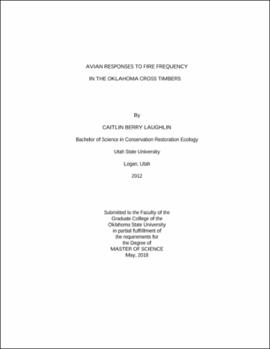| dc.description.abstract | Disturbance in the form of fire is an important ecological process. The presence or long term absence of fire is an important determinant of forest vegetative cover by mediating regeneration, tree establishment, and canopy cover. In temperate forests of North America, a long history of human ignitions produced a fire tolerant landscape that required continued, typically low intensity, disturbance to persist. Since European settlement, concerted fire suppression has been the norm. Low-intensity, dormant-season fires in the Cross Timbers have been found to have a modest influence on canopy cover, but an outsized impact on understory structure and composition. We examined breeding songbird communities in oak-hickory forest in response to a gradient of prescribed fire treatments under 68-100% canopy closure. Point counts for breeding birds, flying insect sampling, and vegetation sampling were conducted at 158 plots in 2015 and 2016 in Okmulgee County, Oklahoma. We used multivariate techniques to elucidate the effects of fire frequency on community composition and used AIC to determine if those variables were important to explaining the densities of 10 avian species. Fire treatments had the expected effect on understory vegetation, but no discernible effect on abundance and biomass of flying insect orders, and a comparatively small effect on breeding bird community composition. Increased fire frequency resulted in increased densities of Eastern Wood-Pewee (Contopus virens), Summer Tanager (Piranga rubra), and Indigo Bunting (Passerina cyanea), and reductions in the breeding density of Black-and-white Warbler (Mniotilta varia). Of the 10 species tested, three responded positively and one negatively to increases in fire frequency. This suggests that most species do not experience negative population effects of low intensity fire frequency. Assuming a lack of ecological traps, our results suggest that managers in the Central Hardwoods and Cross Timbers can apply biennial fire low-intensity burns that will help them achieve their objectives for restoration without widespread negative population effects to small breeding landbirds. | |
